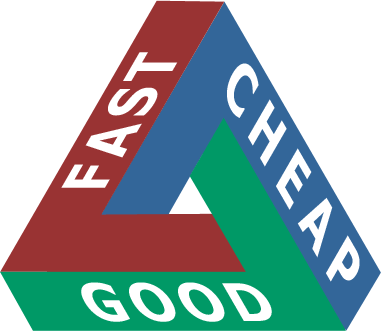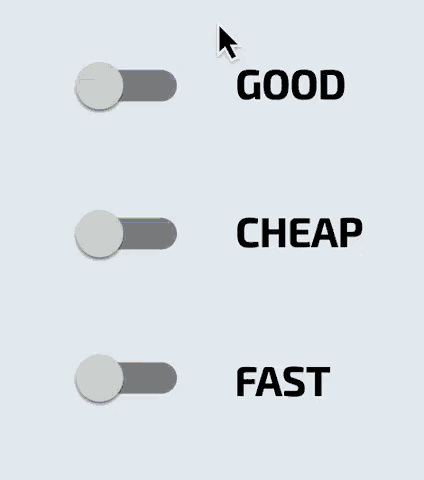Good, Fast, Cheap
Will we fight or surf the "Iron Triangle of Reality"?
I often hear from people looking for a way to record with little or no investment, minimal hassle and study, but excellent results. While it is possible to accidentally fall backwards into a good recording, I thought it might be useful to introduce the IRON TRIANGLE OF REALITY into the discussion. In the recording industry (and many others), this is a well-known phenomenon, a virtual law of physics, if you will. It is a law that is often challenged but rarely beaten. I'll illustrate with a graphic found on a website:

- PICK TWO -
Here's the gist of this phenomenon:
Good+Fast=Expensive
In order to pull off "good" and "fast," you generally need excellent gear, a great recording space, an excellent engineer, and a plan. None of that is cheap.
Good+Cheap=Slow
To cheat the expense side of things, you need to do research to find good, inexpensive equipment, to treat your recording environment, and to learn techniques through reading and trial-and-error, to achieve good recordings. None of that is fast. However, it is do-able!
Fast+Cheap=Inferior (and often frustrating)
Starting from scratch, the average person can't quickly learn how to make satisfying recordings cheaply. Believe it or not, recording is an art and science that requires some learning and some thought. This is partially because many of the physical phenomena surrounding it are counter-intuitive and partially because it takes experience to merge taste and technique. While rocket science it ain't, it does take time.
It used to be that high-quality recording had to be earned. In the 1950s and 1960s, the gear, facilities, and personel required to create excellent recordings were in the hands of the record labels. Having access meant having been screened by multiple label people and judged to be a good prospect to make money for them. In the 1970s there was a trend toward independent recording studios. However, the hourly cost of those studios was astronomical. To record there you had to have a really large sum of money to pay for what was referred to as an "ego record." However, recent trends have changed all that and "democratized" recording. Inexpensive and intuitive non-linear computer recording has made it possible for everyone to be a recordist. Manufacturers who knock-off of expensive European gear and manufacture it in Asia have made really good gear available on the cheap, if you know what to buy.. I guess we have Teac/Tascam to thank for setting the trend starting back in the '70s, eh? So, if you consider recording to be a hobby into which you can pour some time and money, you can eventually assemble the gear, environment, skills, and techniques to accomplish your recordings, and do it fairly inexpensively.
In the 1980s, my studio acquired a vintage Telefunken (Neumann) U-47 condenser microphone from the estate of a well-endowed individual. In 1957, this person had decided to go into home recording, so he invested in the very best recording gear available at the time. Twenty-five years later his gear was discovered in virtually unused condition in the bottom of a closet. Today, these original U-47s are considered among the most sought-after vintage mics and command a price of nearly $10k on the used market. Apparently the original owner discovered that good recordings didn't make themselves because within a few short hours of acquiring his gear, this person gave up and parked it in that closet.
In my own personal experience, I've been recording for over forty years, more than thirty of those professionally. I still learn something new on every project, and study my craft between the projects as well.
Cheers and happy learning!

= =
=


